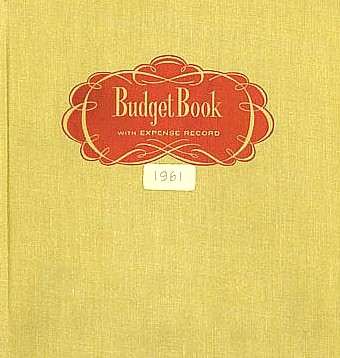

Most American families keep more or less detailed household accounts showing their income and expenses in an attempt to furnish a sound balance with money to spare. Garé and Carl Barks were no exceptions. In fact, Carl - who did the family's budgets - was very careful registering every detail. Since childhood he had been used to a hard financial life, and this stuck with him even in the economically secure years towards the end of his life. In the family's budget books he would even produce lengthy diagrams containing annual summaries and average percentage columns as well as speculative scenarios type 'what if...?'. This page will give you an example of just one month's entries from the Barks couple's budget books. The year is 1961. The month is April.
Although this page concerns personal matters, more sensitive financial information such as detailed figures of investments is not specified. That type of information has no bearing on the page's main subject, which is to present Garé and Carl Barks as they were - ordinary American citizens.
 The Barks couple used this type of budget book which was printed by Whitman Publishing Company, a subsidiary of Carl's employer Western Publishing. The book came formatted with all needed columns for 12 months as well as memo pages to be used for more detailed information. Carl would normally use these pages to their fullest ability. The book ended with a calendar spanning 6 years. |
EXPLANATORY REMARKS
INCOME RECORD Salary: Bonusses: Dividends: Paintings: |
SAVINGS RECORD The records show no sign of the couple having life insurances, but they frequently invested in both funds and real estate. Their biggest purchase was 'a bare lot' (as Barks booked it) at Gig Harbor in Washington State, which they bought in August 1961 for 4,960 dollars. It was their intention to move there when they retired, but that never happened. |
MONTHLY ALLOWANCE FOR SPECIAL ITEMS Taxes: Alimony: |
AUTOMOBILE Barks was always very fond of automobiles and he owned a string of them through his adult years. The couple's transportation needs can be illustrated by Barks' account from 1960, where he owned an older car that clocked 7,400 miles (12.000 kilometers) at the end of the year. |
SHELTER Rent: Miscellaneous: |
CLOTHING New clothing: Cleaning, repairs: |
FOOD The entries follow a fairly straight line,
in which the couple shopped regularly for groceries. Two
sets of recurring entries are perhaps a little more
interesting: |
OPERATING EXPENSES Maid: Professional materials: |
OTHER EXPENSES Haircut: Drugs: Newspapers: Postage: |
EXTRA
THE ABSENT EXPENSE When one browses through the budget books it
is striking to notice one expense that is hardly ever
present - Vacation! In interviews Barks said it
repeatedly; they never felt the need - or had the time -
to wind down and leave everything for a couple of weeks. |
POSTSCRIPT If you would like to dig in deeper into the couple's expenses and compare them to today's prices the Internet has an abundance of sites in which you can do just that. http://www.westegg.com/inflation is one of the most simple to use. But notice that you will be searching American facts which may very well be different from those of your country if you are not an American. Judging from each year's budget books up to this point it is fair to conclude that Garé's and Carl's incomes as well as their expenses were rather typical for a small American family. They led financially quiet lives with no excesses, and they were able to save money. |
| http://www.cbarks.dk/THEBUDGETS.htm | Date 2008-04-04 |